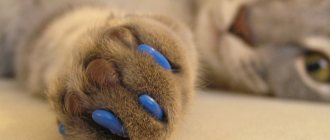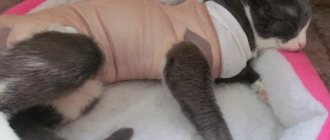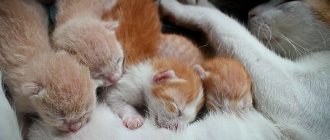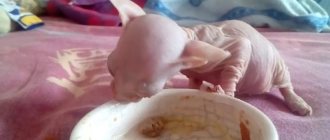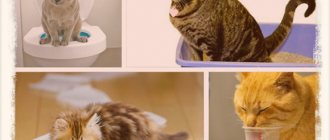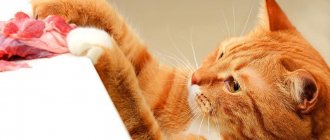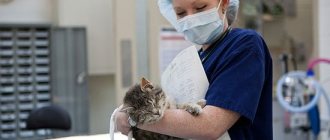The first hours after surgery - your actions
After surgery, the cat begins a rehabilitation period. It needs to be transported home; during transportation it is important to ensure the most comfortable conditions possible. First of all, we recommend purchasing a special container for transporting animals. Lay a soft blanket in it and cover with a waterproof diaper on top. After placing the cat there, cover it with a blanket or warm diaper, because... During anesthesia, body temperature drops, and it is important to prevent hypothermia.
In a normal state, a cat recovers from anesthesia within 1-2 hours. Careful monitoring must be ensured during this time. While the cat is under anesthesia, it may be necessary to lubricate the cornea with a saline solution. In modern clinics, doctors immediately lubricate the animal’s eyes with professional gel - in this case, no additional effort is required from the owner.
In the first minutes after emerging from anesthesia, the cat usually behaves lethargically. Don’t touch her again, don’t pick her up, let her lie down. You can offer your pet water, but you should refrain from eating for a while.
Arrangement of a resting place
At home, a four-legged patient needs a special place to rest and sleep. Choose the quietest corner in the apartment, where there are no drafts and crowds of people are kept to a minimum. Lay a blanket directly on the floor, covering it with disposable diapers on top. It is highly not recommended to place the animal on a sofa or chair, because After anesthesia, the cat’s reactions are inhibited, and it can fall from an elevation, damaging its limbs. Cover your pet with a blanket while sleeping.
Place a bowl of water next to the bed. A little later you can bring food. Also place a tray nearby, but be prepared for the fact that the animal may go to the toilet under itself.
Cat's diet after surgery
In order for the sutures to heal faster after surgery in a cat, and for the animal to come to its senses more quickly, it is necessary to take care of a nutritious, healthy diet. On the first day after anesthesia, however, it should be very moderate. 5-6 hours after waking up, offer your pet liquid food (chicken broth, for example), but
Important: show your pet due attention, and the recovery period will pass easily and quickly.
Don’t force anyone to eat. On the second day, you can give food in the form of puree.
Attention: during rehabilitation, the serving size should be reduced by approximately 2 times. At the same time, meals can be made more frequent.
Pay special attention to the composition of the products. Currently, there are special foods for cats after surgery, rich in vitamins and minerals. As an alternative or supplement, you can use regular baby food, meat and vegetable purees without salt and sugar.
Veterinarians strongly recommend avoiding spicy foods and foods with strong odors. A weakened digestive system does not accept such food. It is also advisable to exclude the usual dry food from the diet. If the cat is so used to them that it refuses other food, soak the salty pads in water. It is best to give food in the form of canned food. Make sure the food is at a comfortable temperature. Hot food, as well as food just taken out of the refrigerator, has a detrimental effect on digestion.
General information
Let's start with safety precautions, which must be followed regardless of the circumstances. Whether your cat is recovering from a dental cleaning or recovering from abdominal surgery, she will experience toxicity until she fully recovers from anesthesia.
All drugs for anesthesia are, roughly speaking, drugs that lead to muscle relaxation and temporary cessation of the sensitivity of certain areas of the brain. Often, while under the influence of anesthesia, a cat hallucinates, sees pictures, hears sounds or senses something that is not there. All these oddities can prompt your pet to take unexpected actions. Unfortunately, many owners have learned from their own experience that a cat can cause serious injury to itself after anesthesia.
To avoid obvious risks, you should do the following:
- Do not leave your cat unattended until it has completely recovered from anesthesia! It is necessary! If you need to leave for a short time, your pet should be locked in a carrier. To make it more convenient while the cat is sleeping, do not take it out of the carrier, but simply remove the lid.
- Place the carrier with the cat on the floor to prevent the pet from falling. Falling from a height is dangerous because the impact causes the cat to tense up and the seams may come apart.
- Close all windows and vents - yes, some cats very quickly “drop in” from the windows of multi-story buildings if they imagine something.
- Immediately after surgery, put an Elizabethan collar or blanket on your cat (as recommended by your doctor). You may not even notice your cat has woken up, but owners have learned that cats' sharp teeth can remove stitches in seconds.
Note! Even if the cat has undergone a standard, simple operation, all sterility measures must be observed during the rehabilitation period!
After castration of the cat, make sure that he does not remove the collar and that the tray filler is clean. After sterilizing your cat, stock up on several blankets so that you can change them as needed.
On the first day after surgery, the cat will not be able to regulate its temperature, so it is important to keep it warm. Make sure that the carrier is not in a draft. If paws feel cool, use a heating pad. Woolen fabric or special thermal blankets help preserve body heat. If the cat is constantly losing temperature, it is placed on a heating pad with a temperature of 38–39.5°, covered with a light piece of wool and foil.
Important! While the cat is sleeping, it needs to be turned from one side to the other every 1.5–2 hours, this stimulates blood circulation and reduces the risk of developing edema.
Please note that the residual effect of anesthesia may last a day or more. Delayed intoxication also happens, especially if the cat has liver or kidney problems. You need to keep watch over your pet for at least a day, so you need to ask someone for help in advance. The cat will sleep, but not deeply, she will hear most of the sounds, so it is important not to fuss. Even if you are worried, speak in a confident tone and remain as calm as possible. You need to understand that the cat is in pain and scared, and your confidence will support it. If your pet tries to raise its head or stand up, immediately indicate your presence with your voice. Perhaps the cat does not want to go anywhere, and its attempts to move are associated with a feeling of loneliness and fear.
Important! If the animal has a large stitch on its body, for example, after surgery to remove a tumor, strictly follow the doctor's instructions for changing the bandages. A stale bandage can cause the wound to become infected and cause itching, which encourages the cat to make unnecessary movements.
About a day after the operation, you will be faced with a very important question - what to feed and whether it is possible to feed the patient. Please note that if the veterinarian has indicated that you cannot feed the cat, this recommendation must be strictly followed. For example, after intestinal surgery, even a small amount of food will cause damage to the suture or inflammation. Hunger weakens the body, so to maintain it, the cat is given IVs with vitamin complexes and buffer solutions.
Seam processing
Until the stitches have healed, the cat should be temporarily isolated from other animals and children, and, if possible, not allowed outside. In the first case, it will be possible to avoid damage to the seams from outdoor games, in the second - their contamination and, as a result, infection. It is also not recommended to wet the seams with water.
During the recovery period, your cat may require dressings. They can be carried out at home. Bandages must be sterile. Before applying the bandage, you need to treat the seam with an antiseptic, which will be prescribed to you by your veterinarian. Most often this is an aqueous solution of chlorhexidine. It is highly undesirable to use iodine and brilliant green for processing.
Postoperative collar – effective suture protection
During recovery, it is important to ensure that the incision site remains intact: the cat should not lick itself. A postoperative (Elizabethan) collar will help protect the sutures or bandage from harmful intrusions. It is a funnel-shaped structure that is placed around the pet’s neck. The protective edge prevents the cat from licking itself, but at the same time does not interfere with food intake.
An Elizabethan collar for a cat can be purchased at a pet store or you can make it yourself from an old large plastic bottle or thick fabric. In this case, the height of the side should correspond to the distance from the neck to the tip of the animal’s nose.
General recommendations
After surgery, the cat’s abdomen is protected with a special blanket or bandage that is tied on the back. Such a protective blanket is constantly on the animal until the stitches are removed, plus or minus a day or two. This is done to prevent the cat from licking wounds from threads.
The blanket is made from natural cotton fabric, which does not physically interfere with the animal after surgery. However, there are times when, due to its sensitivity, the cat is too lazy to walk in this bandage or she walks in an unusual way. As soon as the blanket is removed, everything will return to its place. Be sure to ensure that the cat does not get caught in the blanket to avoid injuring itself.
In what cases should you consult a doctor?
All cats are different, and therefore each one experiences surgery and the post-operative period differently. It happens that not everything goes according to plan, and the help of a veterinarian is required. Therefore, always keep the clinic’s phone number in sight; you may need it in the following cases:
- if body temperature is below 37 °C;
- the cat has not had stool for 3 days or has not urinated for 24 hours;
- purulent discharge came from the stitches, the skin around the incision darkened or swollen;
- after a two-day fast, the appetite does not return, and after taking medications the cat becomes ill (vomiting and behavioral disturbances are observed);
- general health deteriorates.
Why and when are cats neutered?
Cats are castrated for several reasons:
- First, removing reproductive organs prevents unwanted reproduction.
- Secondly, the operation is accompanied by changes in behavior - the animal becomes less aggressive and less prone to escape.
- Finally, the life expectancy of a neutered pet increases by 2-3 years due to the fact that the removal of organs minimizes the risk of developing dangerous pathologies.
At the stage of preparation for the procedure, you need to weigh the pros and cons. But the arguments in favor of the operation usually outweigh - the exception is cats with high breeding value.
The next important step is choosing the optimal age. On the one hand, it is necessary that the operation be as painless and unpleasant as possible. On the other hand, castration makes significant changes in hormonal levels, which is why it is so important that the kitten’s body is fully formed. According to most veterinarians, the ideal age is from 6 to 9-10 months.
Advice! When preparing, consult a veterinarian - he should examine the animal and assess the degree of its physical development.



